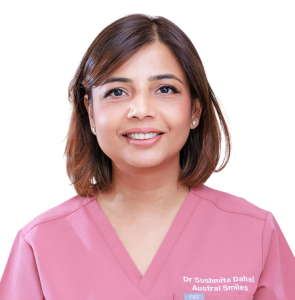Dental Braces and Clear Aligners for Every Smile
Modern Orthodontics in Austral
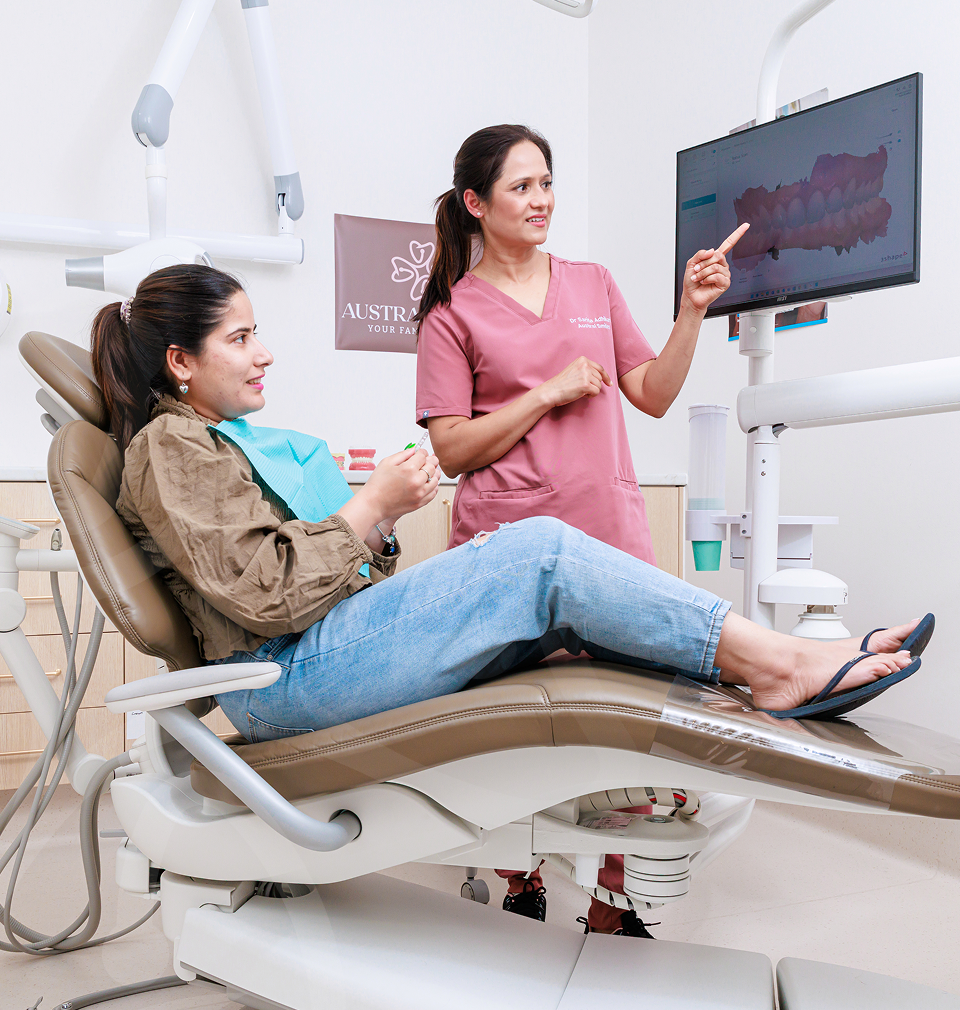
Why Orthodontic Care Matters for Long-Term Oral Health
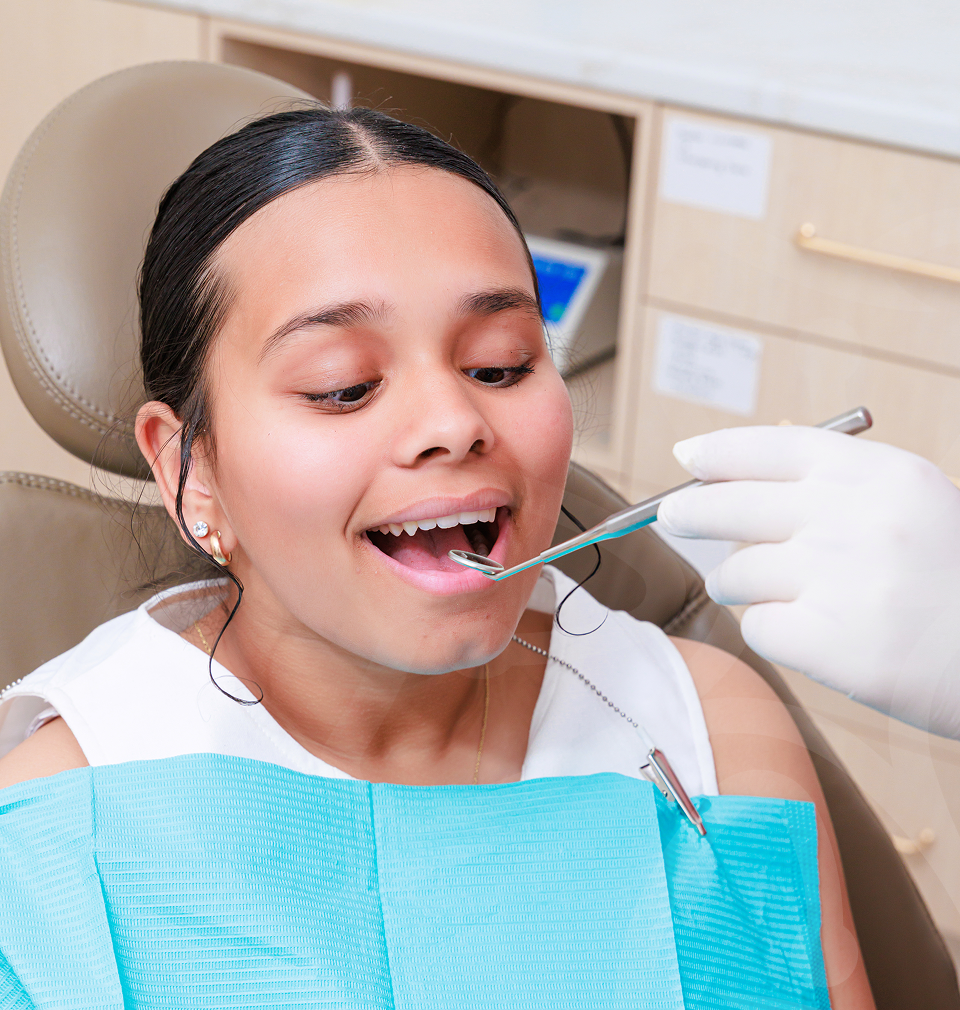
Who Orthodontics Can Help
Crooked Teeth
Mild to moderate crowding can cause teeth to overlap or twist. Straightening helps improve alignment, making it easier to clean and maintain long-term dental health.
Gaps Between Teeth
Spaces between teeth may affect how you bite or smile. Closing gaps with orthodontic treatment can improve both appearance and function.
Jaw Misalignment
Overbites, underbites, or crossbites can lead to uneven pressure on teeth. Braces or aligners can gradually shift the position of the jaw to improve how the teeth come together.
Shifting Teeth After Braces
Teeth can move years after treatment if retainers aren’t worn. Orthodontics can reposition shifting teeth to restore balance and comfort.
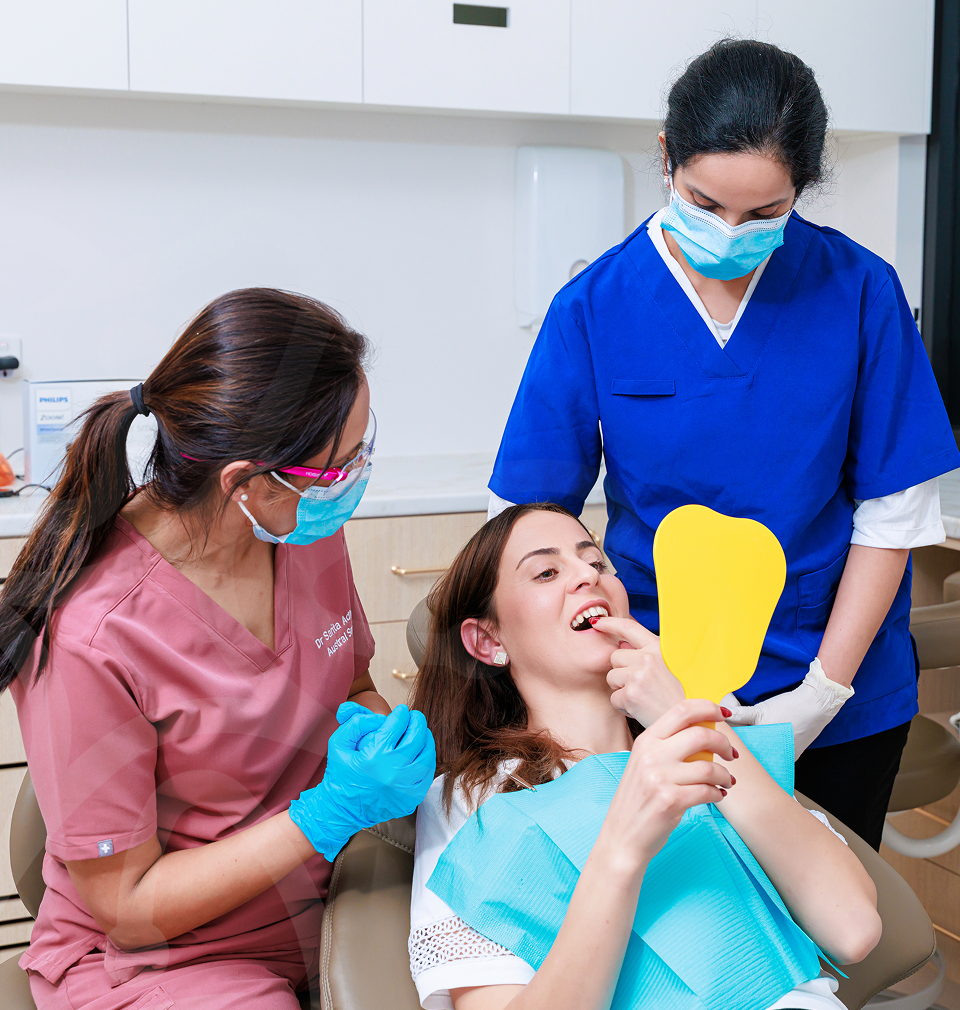
Orthodontics Improves More Than Just Your Smile
Easier Cleaning
Straighter teeth create fewer hard-to-reach areas, making brushing and flossing more effective and helping reduce plaque and food debris build-up.
Better Bite Alignment
Misaligned teeth can affect how your bite fits together. Orthodontics may help guide the bite into a more balanced and functional position.
Less Jaw Pressure
When teeth don’t align well, it can place stress on the jaw. Aligning them may ease tension and improve comfort during chewing or speaking.
Clearer Speech
Tooth positioning can sometimes influence speech. Orthodontic care may support clearer pronunciation by improving how the tongue and teeth interact during certain sounds.

Ready for Straighter Teeth? Let’s Talk
If you’ve been considering aligners or braces, now’s the time to learn more. Speak with our team in Austral and take the first step at your own pace.
Before and After Smile Transformations
Discover real patient smile transformations in our gallery! Keep in mind that every smile is unique, so results may vary.
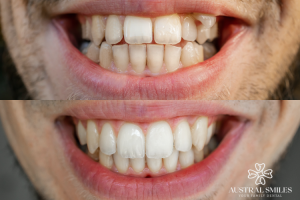
Invisalign
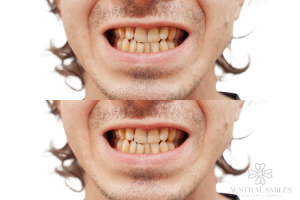
Invisalign
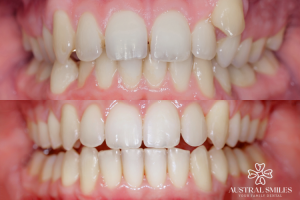
Invisalign

Invisalign

Invisalign

Invisalign

A Welcoming, Supportive Space
Nervous about getting braces or clear aligners? You’re not alone, and you’re in the right place. We create a friendly, pressure-free environment where you feel supported at every appointment.
Flexible Payment Options
Straightening your smile is a big step, and we make it easier with flexible payment plans that help take the pressure off your budget.
Results That Last
We’re not just about quick treatments. We focus on long-term stability. Our carefully planned procedures are designed to help you maintain your beautiful, straight smile for years to come.
Experienced Dentists
With over 30 years of combined experience, our team knows how to plan orthodontic treatments that are effective, comfortable, and tailored to every stage of life, from teens to adults.
Straight Smiles Made Simple
Straight Smiles Made Simple
Getting the smile you’ve always wanted shouldn’t feel complicated or overwhelming. At Austral Smiles, we offer modern orthodontic treatment options — from clear aligners to traditional braces — all designed to fit your life, your style, and your goals.
 A Welcoming, Supportive Space
A Welcoming, Supportive Space
 Results That Last
Results That Last
 Flexible Payment Options
Flexible Payment Options
Straightening your smile is a big step, and we make it easier with flexible payment plans that help take the pressure off your budget.
 Experienced Dentists
Experienced Dentists

Payment Options
We offer a range of flexible payment options to help make your dental care more manageable.
We Accept All Health Funds
We’re a CBHS Choice Network and a nib First Choice Network preferred provider, and we accept all major health funds. Our clinic processes eligible CDBS and government programme claims on the spot for your convenience.

Meet the Experienced Dentists at Austral Smiles
Get to know our friendly dental team, each dedicated to providing personalised care to improve your smile and oral health.
Dr. Sushmita Dahal
DEN0001028720, General Dentist
With over 18 years of experience, Dr. Sushmita Dahal has worked across private, public, and not-for-profit clinics in Australia. She combines technical precision with creative skills in dental artistry and smile rehabilitation.
Learn MoreDr. Mamata Maharjan
DEN0001586185, General Dentist
Dr. Mamata Maharjan has over 15 years of clinical experience in Sydney’s public and private sectors. She focuses on preventive dentistry, root canal therapy, and clear aligner orthodontic treatments for adults and teens.
Learn MoreDr. Bandana Shakya
DEN0001148239, General Dentist
A graduate of Progressive Orthodontic Seminars (USA, 2015), Dr. Bandana Shakya offers implants and orthodontic treatments. She provides Invisalign®, ClearCorrect®, Spark®, ClearPath® aligners and performs complex wisdom teeth extractions. She also completed implant training with Osstem.
Learn MoreDr. Sarita Adhikari
DEN0001677199, General Dentist
Since graduating in 2004, Dr. Sarita Adhikari has delivered preventative, cosmetic, and restorative dental care. She promotes patient education, empowering individuals to take active roles in managing their long-term oral health.
Learn MoreAustral Smiles
average rating
ADA
Member

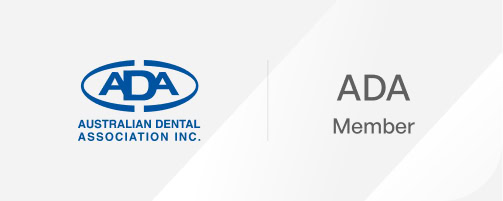
Orthodontic Treatment Questions and Clear Answers
What does orthodontics do?
Orthodontics focuses on improving the position, function, and health of your teeth and jaws. It provides the following benefits:
- Orthodontic treatment identifies issues such as crowded teeth, uneven bites (malocclusions), and jaw alignment problems through clinical exams, X-rays, and digital scans.
- It helps prevent future dental problems by making teeth easier to clean, which can lower the chance of cavities and gum disease.
- Orthodontic care moves teeth and jaws into better positions using braces, clear aligners, and other dental devices.
- It helps guide healthy jaw and facial growth in children, making space for adult teeth to come through properly.
- Orthodontic treatments improve the way teeth fit together, which can make chewing, speaking, and even breathing easier.
- Aligning the teeth and bite can ease pressure on the jaw joints and may reduce the risk of developing temporomandibular joint (TMJ) problems.
- Straightening teeth can also improve the look of your smile, which often builds confidence and enhances well-being.
If you are considering orthodontics in Austral, our team is ready to help you explore the most suitable options for your needs.
What's the difference between general dentistry and orthodontics?
General dentistry and orthodontics both focus on your oral health, but they offer different types of care. Here are the main differences:
Type of Care Provided
- General dentists help maintain the health of your teeth, gums, and overall mouth function.
- Orthodontic providers focus on how your teeth and jaws fit together. They help move teeth into better positions using treatments such as braces or clear aligners.
Goals of Treatment
- General dentistry works to protect your oral health by managing issues such as tooth decay, gum infections, and damaged teeth.
- Orthodontic treatment aims to improve the way your teeth align, helping with chewing, speech, breathing, and appearance.
Common Procedures
- In general dentistry, treatments include scale and cleans, fillings, root canals, crowns, and preventive care.
- In orthodontics, treatments include planning the gradual movement of teeth, installing braces, and fitting Invisalign and retainers.
Timing of Treatment
- General dental care happens regularly, usually every six months, to monitor and maintain oral health.
- Orthodontic treatment is usually planned over months or years, with regular adjustments every few weeks to slowly guide teeth into new positions.
When a Patient Might Need Each
- You might visit a general dentist for a sore tooth, a check-up, a professional clean, or a filling.
- You might seek orthodontic care if you notice crooked teeth, crowding, gaps, or a bite that does not feel comfortable.
Is orthodontics just about braces?
Orthodontics involves much more than just fitting braces. It covers the full diagnosis, planning, and management of tooth and jaw alignment.
Here’s what orthodontic care usually involves:
- Assessment and Diagnosis: Orthodontic care begins with a detailed assessment, including digital scans, X-rays, and bite analysis, to understand how the teeth and jaws are positioned.
- Treatment Planning: After the assessment, a personalised treatment plan is created to help guide the teeth into healthier, more balanced positions.
- Use of Different Appliances: While braces are common, orthodontics also involves the use of clear aligners (like Invisalign), plates, expanders, and retainers based on individual needs.
- Jaw and Bite Management: Orthodontics often focuses on improving the way the teeth and jaws meet, helping with chewing, breathing, and overall oral health.
- Long-Term Maintenance: After active treatment, orthodontic care includes retainers and ongoing monitoring to maintain the new smile for years to come.
If you are looking into orthodontic options in Austral, you will find that treatment plans today involve a wide range of options beyond just traditional braces.
What are the different types of braces?
Many patients exploring options like metal, ceramic, or lingual braces discover a wide range of effective choices when considering dental braces in Austral.
1. Traditional Metal Braces
- Metal braces, crafted from durable stainless steel, are the most commonly used option for orthodontic care.
- Brackets and wires in metal braces gently apply steady pressure to shift teeth into better positions over time.
2. Ceramic Braces
- Ceramic braces function like metal braces but feature clear or tooth-coloured brackets for a more subtle look.
- Because ceramic brackets are more delicate than metal ones, they often need extra care during treatment.
3. Lingual Braces
- Lingual braces are placed on the inner surfaces of the teeth, keeping them hidden from view when you smile.
4. Clear Aligners (such as Invisalign)
- Clear aligners are custom-made trays that gently move teeth into their ideal positions over time.
Is Invisalign considered an orthodontic treatment?
Yes, Invisalign is considered a type of orthodontic care. It uses a series of clear, removable aligners to gradually move teeth into better positions. Here’s what makes it different:
- Invisalign aligners are custom-designed to apply gentle pressure, guiding teeth into place over time.
- The clear, smooth material makes them nearly invisible and comfortable to wear.
- Invisalign is often recommended for mild to moderate issues, including slight crowding, gaps, and minor bite problems.
- Regular check-ups are scheduled to track progress and update aligners as needed.
Invisalign in Austral is commonly used for mild to moderate concerns, especially among adults seeking a subtle and flexible alternative to braces.
At what age should kids have an orthodontic assessment?
Children are usually recommended to have their first orthodontic assessment by the age of 7. Early evaluation helps spot any concerns with jaw development or the way adult teeth are emerging.
Here’s why an early check-up is important:
- By age 7, children usually have baby and adult teeth, making it easier to detect potential alignment problems early.
- Early assessments can identify concerns such as crowding, uneven spacing, jaw discrepancies, or bite issues.
- Addressing problems early can sometimes simplify future orthodontic care or reduce the need for more complex treatments later on.
- Monitoring over time may be all that is needed initially, with full treatment starting when appropriate.
How much do braces cost?
The cost of dental braces in Austral varies depending on the appliance used, treatment time, and how complex your alignment needs are.
- Traditional metal braces start at approximately $3,250.
- Lingual braces, which are attached behind the teeth, also start at $3,250.
- Clear aligners, such as ClearCorrect, generally cost between $2,000 and $9,000.
- Invisalign minor treatment typically starts from $4,500.
- Invisalign full treatment usually ranges between $6,000 and $9,000
Prices can also vary based on your oral health, the materials involved, and any preparation required. Some patients may need additional services, such as extractions or scans, before starting orthodontic care.
Your initial consultation includes a personalised treatment plan. You’ll also receive a full breakdown of expected costs and available payment options.
What's the cheapest option for straightening teeth?
- Metal braces are often considered the most budget-friendly choice for a wide range of orthodontic needs.
- Some clear aligner treatments, such as minor tooth movements with ClearCorrect or Angel Aligner, may offer a lower-cost alternative for simple cases.
- Ceramic and lingual braces tend to involve higher costs due to the special materials and fitting techniques.
At Austral Smiles, your dentist will assess your needs and recommend an approach that balances affordability with strong, long-term oral health outcomes.
While upfront costs matter, it’s equally helpful to consider comfort, maintenance, and treatment time.
Are braces covered by health funds?
Many private health funds offer some level of orthodontic cover, but the amount depends on your policy. Here are some key points:
- Some health funds provide a specific limit for orthodontic care, which may be used over one or several years.
- In many cases, health funds set a maximum orthodontic benefit. After reaching this amount, additional claims may not be available.
- Cover amounts differ between providers and may depend on how long you have held your policy and the level of cover selected.
Patients in Austral are encouraged to contact their health fund directly to understand what benefits are available before beginning orthodontic treatment.
Your dentist will provide an itemised care plan during your consultation, which can help when lodging health fund claims.
Is Invisalign more expensive than traditional braces?
The cost difference between Invisalign and traditional braces depends on your dental needs, the type of appliance used, and treatment length.
Traditional Metal Braces
- Traditional metal braces usually start at $3,250, making them a widely chosen option for a range of alignment concerns.
- These braces stay on the teeth throughout treatment and are often used for cases that require more movement.
- Ongoing adjustments help guide the teeth into new positions over time.
Invisalign Clear Aligners
- Invisalign treatment for minor alignment needs generally starts at $4,500.
- More comprehensive Invisalign plans usually range between $6,000 and $9,000, depending on the number of aligners required.
- Aligners are removable and barely noticeable, which many patients find more convenient for day-to-day life.
- The trays can be taken out for meals, brushing, or special occasions, offering added flexibility.
How much does Invisalign cost?
- For minor alignment needs, Invisalign treatment generally starts from around $4,500.
- For more involved cases requiring full treatment, costs usually range between $6,000 and $9,000.
- Additional factors, such as the number of aligner sets needed and the need for retainers at the end of treatment, can influence the total cost.
Are payment plans available for orthodontic treatment?
- Payment plans allow the cost of braces or clear aligners to be spread over time, making it easier to manage than paying upfront.
- Options are generally flexible and may include fortnightly or monthly instalments arranged through third-party finance providers.
- Some plans may be interest-free for a set period, depending on the finance provider and terms selected.
Every patient at Austral Smiles receives a full cost breakdown and available payment options before beginning orthodontic treatment.
Flexible payment arrangements can make it easier to start your orthodontic journey without unnecessary financial pressure.
Is orthodontic treatment worth the cost?
Orthodontic care can offer many long-term benefits, but deciding whether it is worth the investment depends on your goals, needs, and circumstances. Here are some important considerations:
- Aligned teeth are generally easier to clean, which can lower the risk of tooth decay, gum disease, and other dental concerns.
- Improved bite alignment can support better chewing, speech, and jaw comfort over time.
- A more aligned smile can improve confidence and positively impact social and professional interactions.
- For families across Austral, staged treatment options and payment plans are available to help make orthodontic care more accessible.
It is important to weigh the potential health and lifestyle benefits against the financial commitment and to discuss all options with your dentist during a consultation.

